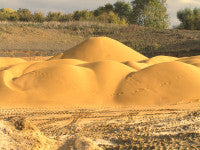Sands of Time
 We tend to take for granted the vast range of products available to our ever-demanding consumer market place, not realising how many of the materials used in these products have their origins in a quarry in Leighton Buzzard. Silica sand and gravel, for example is used in water filtration and found in many common place products such as adhesives, grouts, tiles, bricks and pet care products to name a few.
We tend to take for granted the vast range of products available to our ever-demanding consumer market place, not realising how many of the materials used in these products have their origins in a quarry in Leighton Buzzard. Silica sand and gravel, for example is used in water filtration and found in many common place products such as adhesives, grouts, tiles, bricks and pet care products to name a few.
In the sports turf industry, we associate the use of sand and gravel in pitch drainage schemes, top dressing and Rootzones, with some of our best quality aggregates coming from this same quarry in Bedfordshire.
Garside Sands has been extracting materials from the Leighton Buzzard quarry for well over 100 years. The firm was founded by George Garside in the 1890s, when sand was dug by hand and sold locally to produce tiles and bricks. Today, the firm still operates with a 'family business' philosophy to customer service.
The sands were formed millions of years ago during the Cretaceous period, a time when most of the land in Bedfordshire was under the sea. The action of the waves created the silica deposits we see today - layers of different coloured sand, pure white in places, depending on the level of oxidation that took place.

The process of sand extraction begins with the removal of any over burden covering the sand deposits. Large dumper trucks and 360 degree diggers are kept busy removing this material, which in some places consists of 20 metre-thick local clay soils.
The timing of the removal work is critical as it can only be done in the summer when the clay is relatively dry. Trying to operate and move this overburden in the winter is nigh on impossible so there is only a small window of opportunity each year.
Once the sand has been exposed, it is excavated and transported to the washing and grading plants. The selection of sands is based on customer demand and relies on the skill of the extraction operator to select the appropriate sand seams.
The sand is then transported via a conveyor belt system through a series of washing and grading processes, before being dried and sieved to produce the finished product. The final part of the process is the bagging of the sands in a variety of sizes to meet customer requirements.

Garside operate from several sites in the Leighton Buzzard area, and most are quarried in the traditional way with diggers. However, its Grovebury deposit is very different. Here, the sands are located under a natural lake and are removed by dredger, which enhances the washing process.
Leighton Buzzard sands have a high silica content of more than 90 per cent which makes them hardwearing and durable. The sands also have a sub-angular to rounded grain shape making them more technically suitable for use in a wide range of industries.
From its four operating quarries the company supplies in excess of thirty-five products, including fifteen specialist dried sands, seven damp sands, four bunker sands and three sand/soil Rootzone products. Garside also produce a range of coloured sand for sports and decorative uses.
Today, Garside Sands operates as a significant part of Aggregate Industries Limited, an environmentally responsible producer of high-quality aggregate-based construction materials in the UK and US. Aggregate Industries was acquired in 2005 by Holcim, one of the world's leading sup
 pliers of cement and aggregates, ready-mixed concrete, asphalt and related services with interests in more than 70 counties. Aggregate Industries' backing has enabled Garside to embark on a number of new marketing and investment programmes.
pliers of cement and aggregates, ready-mixed concrete, asphalt and related services with interests in more than 70 counties. Aggregate Industries' backing has enabled Garside to embark on a number of new marketing and investment programmes.
One of these is the recent investment of over £1 million in new equipment and machinery at the quarry. A new washing facility is already up and running together with a new bagging plant, and a new dryer is only weeks away from being commissioned. These investments will not only enable Garside to offer a wider range of products with greater production flexibility, but also offer significant benefits in terms of sustainability.
Further investment has been committed to research and development, under the control of newly appointed Product Development Manager James Cook. James' background is in the construction and maintenance of sports surfaces and he has recently graduated from Cranfield University with an MSc in Sports Surface Technology. His role will be to investigate the opportunities for developing new products for the sports turf industry, working closely with groundsmen and greenkeepers.
 Garside Sands, like other aggregate suppliers, has invested heavily in research, development and plant processes to ensure the products produced are consistent and meet stringent customer specifications. Education is the key to understanding how these specialist products perform and how they should be handled and used.
Garside Sands, like other aggregate suppliers, has invested heavily in research, development and plant processes to ensure the products produced are consistent and meet stringent customer specifications. Education is the key to understanding how these specialist products perform and how they should be handled and used.
For example, in response to increasing concerns for animal in greyhound racing, Garside Sands has been working closely with the industry to develop Starmat ®. Currently in the final stages of development, it is hoped the imminent launch of this material will offer many significant benefits to both animals and stadium owners.
The educative role that the aggregates business can play in the use of recycled materials is especially key. John Robins, the company's Sales Manager for the South of England and Ireland, was keen to point out that, a nation, we must improve our attitude towards the use of recycled materials. He said "The natural deposits of quality silica sand and gravel will not last forever. We therefore need to develop sustainable alternatives now." To that aim, Garside is currently developing uses for recycled bottle glass.
One such development project involves the blending of recycled glass with sand from Garside to produce a new bunker sand. The properties of the recycled glass are such that when mixed with the sand particles it produces a more stable product. This helps to prevent sand migration and sand plugging, whilst retaining porosity.
Quarrying has tended to be a somewhat contentious activity, with questions about the scale of the operations and particularly the environmental impact. However, my visit to the Heath and Reach quarry allayed any of the concerns I may have had.

From the road the impact on the landscape is barely noticeable. You could easily drive past and not see or hear any noticeable evidence of operations taking place. The company is very mindful of its commitment to the environment and sustainability, and works very closely with local authorities, organisations and the community to ensure that standards are maintained.
Noise and pollution is kept to a minimum and excavations are timed to fit in with wildlife activities. For example, a sand martin colony has set up home on part of the sand excavations, and these areas are protected during the nesting season. Likewise, there is an ongoing restoration of quarried land with the planting of trees to provide a habitat for local wildlife. The lagoons also provide an ideal environment for birds and mammals. While on site I saw a number of herons feeding from the lagoons.
Garside Sands sees the way forward as investment in people and plant, whilst continually improving its environmental performance. With the investments being made in new technology, and the willingness of Garside Sands to remain 'good neighbours' to the local community, the prospect of a sustainable future look very promising.
Article Tags:
Industry news